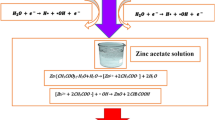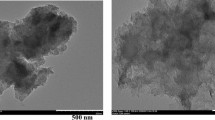Abstract
Nitrogen do** is an effective way to improve the electrical and catalytic properties of graphene. Here, we used a non-thermal plasma technique with AC rotating arc to prepare nitrogen-doped graphene. This method does not need catalyst and can produce nitrogen-doped graphene in the atmospheric environment by large scale. CH4 as the carbon source and N2 as the nitrogen source, nitrogen-doped graphene was obtained by plasma direct synthesis. The nitrogen content in the product was analyzed by X-ray photoelectron spectroscopy and the do** level was about 1.19 at.%. It was found that H2 and CO2 as carrier gases can change the nitrogen do** type and content. When there was only N2, pyrrolic N and graphitic N were the main forms in the graphene. The addition of H2 improved the selectivity of pyridinic N and pyrrolic N, but decreased the nitrogen do** content. CO2 significantly increased the selectivity of pyrrolic N and increased the nitrogen do** content. In addition, the formation mechanism of nitrogen-doped graphene was briefly described in this paper. The key in this plasma production technology is to understand the effect of carrier gas on nitrogen do**, which is also instructive for mass production in industry.









Similar content being viewed by others
Data availability
All data used in this study are available upon request from the corresponding author.
References
Novoselov KS, Geim AK, Morozov SV, Jiang D, Zhang Y, Dubonos SV, Grigorieva IV, Firsov AA (2004) Electric field effect in atomically thin carbon films. Science 306:666. https://doi.org/10.1126/science.1102896
Razaq A, Bibi F, Zheng XX, Papadakis R, Jafri SHM, Li H (2022) Review on graphene-, graphene oxide-, reduced graphene oxide-based flexible composites: from fabrication to applications. Materials 15:17. https://doi.org/10.3390/ma15031012
Olabi AG, Abdelkareem MA, Wilberforce T, Sayed ET (2021) Application of graphene in energy storage device—a review. Renew Sust Energ Rev 135:20. https://doi.org/10.1016/j.rser.2020.110026
Dai CL, Sun GQ, Hu LY, **ao YK, Zhang ZP, Qu LT (2020) Recent progress in graphene-based electrodes for flexible batteries. InfoMat 2:509. https://doi.org/10.1002/inf2.12039
Naghibi S, Kargar F, Wright D, Huang CYT, Mohammadzadeh A, Barani Z, Salgado R, Balandin AA (2020) Noncuring graphene thermal interface materials for advanced electronics. Adv Electron Mater 6:9. https://doi.org/10.1002/aelm.201901303
Esteve-Adell I, Porcel-Valenzuela M, Zubizarreta L, Gil-Agusti M, Garcia-Pellicer M, Quijano-Lopez A (2022) Influence of the specific surface area of graphene nanoplatelets on the capacity of lithium-ion batteries. Front Chem 10:10. https://doi.org/10.3389/fchem.2022.807980
Wang H, Ma CQ, Zhang WM, Cheng HM, Zeng Y (2019) Improved dam** and high strength of graphene-coated nickel hybrid foams. ACS Appl Mater Interfaces 11:42690. https://doi.org/10.1021/acsami.9b10382
Lonkar SP, Deshmukh YS, Abdala AA (2015) Recent advances in chemical modifications of graphene. Nano Res 8:1039. https://doi.org/10.1007/s12274-014-0622-9
Okano K, Koizumi S, Silva SRP, Amaratunga GAJ (1996) Low-threshold cold cathodes made of nitrogen-doped chemical-vapour-deposited diamond. Nature 381:140. https://doi.org/10.1038/381140a0
Vesel A, Zaplotnik R, Primc G, Mozetic M (2020) A review of strategies for the synthesis of n-doped graphene-like materials. Nanomaterials 10:36. https://doi.org/10.3390/nano10112286
Dey A, Chroneos A, Braithwaite NS, Gandhiraman RP, Krishnamurthy S (2016) Plasma engineering of graphene. Appl Phys Rev 3:19. https://doi.org/10.1063/1.4947188
Zhang Y, Talapatra S, Kar S, Vajtai R, Nayak SK, Ajayan PM (2007) First-principles study of defect-induced magnetism in carbon. Phys Rev Lett 99:4. https://doi.org/10.1103/PhysRevLett.99.107201
Bertoti I, Mohai M, Laszlo K (2015) Surface modification of graphene and graphite by nitrogen plasma: determination of chemical state alterations and assignments by quantitative X-ray photoelectron spectroscopy. Carbon 84:185. https://doi.org/10.1016/j.carbon.2014.11.056
Yamada Y, Kim J, Matsuo S, Sato S (2014) Nitrogen-containing graphene analyzed by X-ray photoelectron spectroscopy. Carbon 70:59. https://doi.org/10.1016/j.carbon.2013.12.061
Bianco GV, Sacchetti A, Grande M, D’Orazio A, Milella A, Bruno G (2022) Effective hole conductivity in nitrogen-doped CVD-graphene by singlet oxygen treatment under photoactivation conditions. Sci Rep 12:11. https://doi.org/10.1038/s41598-022-12696-2
Qu LT, Liu Y, Baek JB, Dai LM (2010) Nitrogen-doped graphene as efficient metal-free electrocatalyst for oxygen reduction in fuel cells. ACS Nano 4:1321. https://doi.org/10.1021/nn901850u
Geng DS, Chen Y, Chen YG, Li YL, Li RY, Sun XL, Ye SY, Knights S (2011) High oxygen-reduction activity and durability of nitrogen-doped graphene. Energy Environ Sci 4:760. https://doi.org/10.1039/c0ee00326c
Zhao HB, Wang WD, Lu QF, Lin TT, Lin QL, Yang HJ (2015) Preparation and application of porous nitrogen-doped graphene obtained by co-pyrolysis of lignosulfonate and graphene oxide. Bioresour Technol 176:106. https://doi.org/10.1016/j.biortech.2014.11.035
Ai S, Chen YX, Liu YL, Zhang Q, **ong LJ, Huang HB, Li L, Yu XH, Wei L (2018) Facile synthesis of nitrogen-doped graphene aerogels for electrochemical detection of dopamine. Solid State Sci 86:6. https://doi.org/10.1016/j.solidstatesciences.2018.09.014
Yen PJ, Ilango PR, Chiang YC, Wu CW, Hsu YC, Chueh YL, Wei KH (2019) Tunable nitrogen-doped graphene sheets produced with in situ electrochemical cathodic plasma at room temperature for lithium-ion batteries. Mater Today Energy 12:336. https://doi.org/10.1016/j.mtener.2019.01.003
Zan R, Altuntepe A (2020) Nitrogen do** of graphene by CVD. J Mol Struct 1199:6. https://doi.org/10.1016/j.molstruc.2019.127026
Li ZX, Li XH, Zong Y, Tan GG, Sun Y, Lan YY, He M, Ren ZY, Zheng XL (2017) Solvothermal synthesis of nitrogen-doped graphene decorated by superparamagnetic Fe3O4 nanoparticles and their applications as enhanced synergistic microwave absorbers. Carbon 115:493. https://doi.org/10.1016/j.carbon.2017.01.036
Yasuda S, Yu L, Kim J, Murakoshi K (2013) Selective nitrogen do** in graphene for oxygen reduction reactions. Chem Commun 49:9627. https://doi.org/10.1039/c3cc45641b
Terasawa T, Saiki K (2012) Synthesis of nitrogen-doped graphene by plasma-enhanced chemical vapor deposition. Jpn J Appl Phys 51:4. https://doi.org/10.1143/jjap.51.055101
Kumar A, Voevodin AA, Paul R, Altfeder I, Zemlyanov D, Zakharov DN, Fisher TS (2013) Nitrogen-doped graphene by microwave plasma chemical vapor deposition. Thin Solid Films 528:269. https://doi.org/10.1016/j.tsf.2012.07.142
Zhong RP, Hong RY (2020) Continuous preparation and formation mechanism of few-layer graphene by gliding arc plasma. Chem Eng J 387:10. https://doi.org/10.1016/j.cej.2020.124102
Wu AJ, Li XD, Yan JH, Yang J, Du CM, Zhu FS, Qian JY (2017) Co-generation of hydrogen and carbon aerosol from coalbed methane surrogate using rotating gliding arc plasma. Appl Energy 195:67. https://doi.org/10.1016/j.apenergy.2017.03.043
Ma J, Chen XH, Song M, Wang C, **a WD (2021) Study on formation mechanism of three types of carbon nanoparticles during ethylene pyrolysis in thermal plasmas. Diam Relat Mat 117:9. https://doi.org/10.1016/j.diamond.2021.108445
Luo ZY, Li YY, Wang FF, Hong RY (2019) Plasma exfoliated graphene: preparation via rapid, mild thermal reduction of graphene oxide and application in lithium batteries. Materials 12:11. https://doi.org/10.3390/ma12050707
Wang FF, Zhang X, Hong RY, Lu XS, Zhu Y, Zheng Y (2021) High-performance anode of lithium ion batteries with plasma-prepared silicon nanoparticles and a three-component binder. Electrochim Acta 390:11. https://doi.org/10.1016/j.electacta.2021.138809
Wang F, Wang FF, Hong RY, Lv XS, Zheng Y, Chen HY (2020) High-purity few-layer graphene from plasma pyrolysis of methane as conductive additive for LiFePO4 lithium ion battery. J Mater Res Technol 9:10004. https://doi.org/10.1016/j.jmrt.2020.06.072
Wang C, Sun L, Dai XY, Li DN, Chen XH, **a WL, **a WD (2019) Continuous synthesis of graphene nano-flakes by a magnetically rotating arc at atmospheric pressure. Carbon 148:394. https://doi.org/10.1016/j.carbon.2019.04.015
Lee DH, Kim KT, Cha MS, Song YH (2007) Optimization scheme of a rotating gliding arc reactor for partial oxidation of methane. Proc Combust Inst 31:3343. https://doi.org/10.1016/j.proci.2006.07.230
Singh M, Sengupta A, Zeller K, Skoptsov G, Vander Wal RL (2019) Effect of hydrogen concentration on graphene synthesis using microwave-driven plasma-mediated methane cracking. Carbon 143:802. https://doi.org/10.1016/j.carbon.2018.11.082
Beams R, Cancado LG, Novotny L (2015) Raman characterization of defects and dopants in graphene. J Phys Condes Matter 27:26. https://doi.org/10.1088/0953-8984/27/8/083002
Ferrari AC, Basko DM (2013) Raman spectroscopy as a versatile tool for studying the properties of graphene. Nat Nanotechnol 8:235. https://doi.org/10.1038/nnano.2013.46
** Z, Yao J, Kittrell C, Tour JM (2011) Large-scale growth and characterizations of nitrogen-doped monolayer graphene sheets. ACS Nano 5:4112. https://doi.org/10.1021/nn200766e
Yen HF, Horng YY, Hu MS, Yang WH, Wen JR, Ganguly A, Tai Y, Chen KH, Chen LC (2015) Vertically aligned epitaxial graphene nanowalls with dominated nitrogen do** for superior supercapacitors. Carbon 82:124. https://doi.org/10.1016/j.carbon.2014.10.042
Geng DS, Yang SL, Zhang Y, Yang JL, Liu J, Li RY, Sham TK, Sun XL, Ye SY, Knights S (2011) Nitrogen do** effects on the structure of graphene. Appl Surf Sci 257:9193. https://doi.org/10.1016/j.apsusc.2011.05.131
Reina A, Jia XT, Ho J, Nezich D, Son HB, Bulovic V, Dresselhaus MS, Kong J (2009) Layer area, few-layer graphene films on arbitrary substrates by chemical vapor deposition. Nano Lett 9:3087. https://doi.org/10.1021/nl901829a
Ferrari AC, Meyer JC, Scardaci V, Casiraghi C, Lazzeri M, Mauri F, Piscanec S, Jiang D, Novoselov KS, Roth S, Geim AK (2006) Raman spectrum of graphene and graphene layers. Phys Rev Lett 97:4. https://doi.org/10.1103/PhysRevLett.97.187401
Childress A, Parajuli P, Eyley S, Thielemans W, Podila R, Rao AM (2019) Effect of nitrogen do** in the few layer graphene cathode of an aluminum ion battery. Chem Phys Lett 733:5. https://doi.org/10.1016/j.cplett.2019.136669
Zhang CK, Lin WY, Zhao ZJ, Zhuang PP, Zhan LJ, Zhou YH, Cai WW (2015) CVD synthesis of nitrogen-doped graphene using urea. Sci China-Phys Mech Astron 58:6. https://doi.org/10.1007/s11433-015-5717-0
Li BF, Zhang ST, Cui CJ, Qian WZ, ** Y (2022) Comprehensive review on nitrogen doped graphene structure characterization growth strategy and capacitive energy storage. Energy Fuels 37(2):902–918. https://doi.org/10.1021/acs.energyfuels.2c03517
Lu ZS, Wang C, Chen XH, Song M, **a WD (2021) Effects of buffer gas on N-doped graphene in a non-thermal plasma process. Diam Relat Mat 118:10. https://doi.org/10.1016/j.diamond.2021.108548
Li JY, Ren ZY, Zhou YX, Wu XJ, Xu XL, Qi M, Li WL, Bai JT, Wang L (2013) Scalable synthesis of pyrrolic N-doped graphene by atmospheric pressure chemical vapor deposition and its terahertz response. Carbon 62:330. https://doi.org/10.1016/j.carbon.2013.05.070
Fujimoto Y, Saito S (2011) Energetics and electronic structures of pyridine-type defects in nitrogen-doped carbon nanotubes. Phys E 43:677. https://doi.org/10.1016/j.physe.2010.07.027
Son BK, Lee KH, Kim TH, Shin MS, Choi SY, Cho G (2019) Purification and nitrogen do** of nanothin exfoliated graphite through RF thermal plasma treatment. Nanomaterials 9:11. https://doi.org/10.3390/nano9070995
Matsuo Y, Maruyama S, Cheng Q, Okamoto Y, Tamura N (2021) ELECTROCHEMICAL properties of nitrogen-doped carbons prepared by the thermal reduction of furfurylamine-intercalated graphite oxide. Carbon 175:607
Bhattacharjya D, Park HY, Kim MS, Choi HS, Inamdar SN, Yu JS (2014) Nitrogen-doped carbon nanoparticles by flame synthesis as anode material for rechargeable lithium-ion batteries. Langmuir 30:318. https://doi.org/10.1021/la403366e
Chen XH, Wang C, Song M, Ma J, Ye TH, **a WD (2019) The morphological transformation of carbon materials from nanospheres to graphene nanoflakes by thermal plasma. Carbon 155:521. https://doi.org/10.1016/j.carbon.2019.08.077
Wang C, Song M, Chen XH, Li DN, **a WD (2020) Synthesis of few-layer graphene flakes by magnetically rotating arc plasma: effects of input power and feedstock injection position. Appl Phys A Mater Sci Process 126:13. https://doi.org/10.1007/s00339-020-3399-6
Song M, Wang C, Chen XH, Ma J, **a WD (2021) Large-scale in-situ synthesis of nitrogen-doped graphene using magnetically rotating arc plasma. Diam Relat Mat 116:9. https://doi.org/10.1016/j.diamond.2021.108417
Acknowledgements
This research was financially supported by National Natural Science Foundation of China (NSFC, No. 22278080), Minjiang Scholarship of Fujian Province (No. Min-Gaojiao [2010]-117), Central-government Guided Fund for Local Economic Development (No. 830170778), R&D Fund for Strategic Emerging Industry of Fujian Province (No. 82918001), International Cooperation Project of Fujian Science and Technology Department (No. 830170771), Open Fund of Fujian Key Laboratory of New Energy Generation and Power Conversion (No. KLIF-202102), 111 Project (No. D17005) and Analytical Testing Fund of Qingyuan Innovation Laboratory of Fujian Province.
Author information
Authors and Affiliations
Contributions
RZ: Writing—original draft, Data curation, Conceptualization, Methodology. FZ: Formal analysis, Investigation. Validation, software. JZ: Investigation, Visualization. XL & RH: Writing—review & editing.
Corresponding author
Ethics declarations
Conflict of interest
The authors declare that they have no conflict of interest.
Additional information
Handling Editor: Annela M. Seddon.
Publisher's Note
Springer Nature remains neutral with regard to jurisdictional claims in published maps and institutional affiliations.
Rights and permissions
Springer Nature or its licensor (e.g. a society or other partner) holds exclusive rights to this article under a publishing agreement with the author(s) or other rightsholder(s); author self-archiving of the accepted manuscript version of this article is solely governed by the terms of such publishing agreement and applicable law.
About this article
Cite this article
Zhong, R., Lu, X., Zheng, F. et al. Effect of carrier gas on nitrogen-doped graphene in AC rotating arc plasma. J Mater Sci 58, 8742–8756 (2023). https://doi.org/10.1007/s10853-023-08585-2
Received:
Accepted:
Published:
Issue Date:
DOI: https://doi.org/10.1007/s10853-023-08585-2




